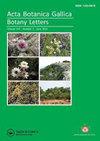Four seed-quality measures in orchids with different pollination systems
引用次数: 9
Abstract
Abstract The number of seeds is an indicator of plant fitness. We compared four quality measures – seed number, abortion, viability and germination. To test as wide a span of seed variability as possible, we cross-pollinated and self-pollinated one nectarless and one nectar-rewarding orchid species, assuming that nectariferous species should be more adapted to geitonogamous selfing than the cheating one and that seed quality should reflect that. Seed number for both species was lowest in selfed fruits. Viability and germination did not show any difference in deceptive Orchis militaris treatments, but the trend was different in rewarding Platanthera bifolia. Seed number and seed abortion correlated well as did viability and germination in vitro. This shows that these two stages are controlled by different mechanisms. Therefore, seed number or seed abortion rate alone cannot be proxies for reproductive output.不同授粉系统兰科植物种子品质的四种测定方法
摘要种子数是植物适合度的一个指标。我们比较了种子数、败育率、生存力和发芽率四个质量指标。为了测试尽可能广泛的种子变异性,我们对一种无花蜜的兰花和一种有花蜜的兰花进行了异花授粉和自花授粉,假设有花蜜的兰花比有花蜜的兰花更适应雌雄同体的自交,并且种子质量应该反映这一点。两种种子数在自交果实中最低。在诱骗性军兰处理中,植物的生存力和发芽率无显著差异,而在奖励性双歧花处理中则有显著差异。种子数与种子败育的相关性较好,离体种子活力与萌发的相关性也较好。这说明这两个阶段受不同的机制控制。因此,单凭种子数或种子败育率不能代表生殖产量。
本文章由计算机程序翻译,如有差异,请以英文原文为准。
求助全文
约1分钟内获得全文
求助全文

 求助内容:
求助内容: 应助结果提醒方式:
应助结果提醒方式:


